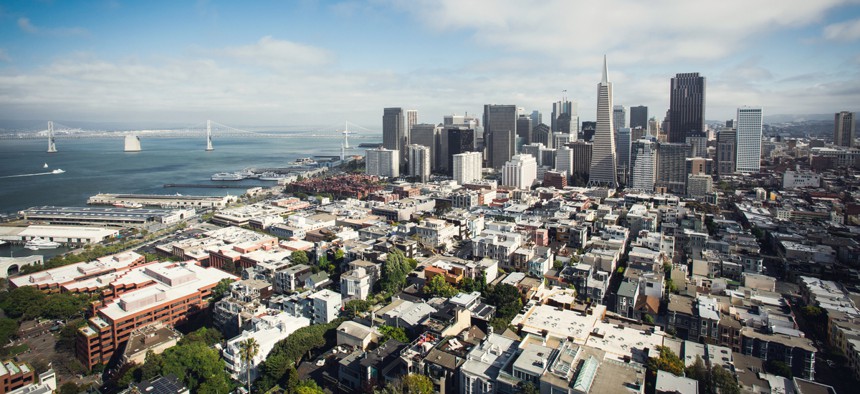The Complex Relationship Between Innovation and Economic Segregation

San Francisco Yulia Mayorova/Shutterstock.com
It’s not just the tech industry that’s responsible for America’s stratifying cities.
Not too long ago, cities were bending over backward to attract high-tech companies, which they saw as offering good, high paying jobs. City after city developed programs designed to turn them into the “next Silicon Valley.”
But now, from the backlash against Airbnb and Uber to protests over high-tech companies and their shuttle busses, high-tech companies are increasingly seen more as villains than saviors, to blame for making cities less affordable and for the growing gap between the rich and the poor. Indeed, America’s leading high-tech centers—the Bay Area, Boston, New York, Washington D.C., Austin, San Diego, and Raleigh all rank highly on various measures of wage and income inequality.
But to what degree do high-tech industry and economic segregation go together?
A new study by me and my colleague, Charlotta Mellander, takes a deep dive into this issue. Our analysis covers the majority of America’s 350-plus metros. Within them, we measure innovation both in terms of patents (the most commonly used measure of innovation by economists) and the concentration of high-tech industry. We measure economic segregation through several models based on income, education, and occupation, as well as a combined measure of overall economic segregation based on all three.
Using these models, we first look at the connection between the levels of innovation and economic segregation in 2010 (the latest year complete data are available for). We then look at the connection between innovation and the growth of economic segregation between 2000-2010. Using a combination of statistical tools (regression analysis and Principal Component Analysis), we examine the connections between innovation, high-tech industry and economic segregation. We control for factors like the population size, average income, and education levels of metros as well as levels of income inequality in order to make a distinction between high tech in and of itself, and some of the factors that it may bring along with it.
At first glance, innovation, high-tech industry and economic segregation appear to be closely connected. A simple correlation analysis shows a close connection between economic segregation and patented innovations (0.26) and an even closer connection between economic segregation and the concentration of high-tech industry (0.63). The former is roughly the same as the correlation between economic segregation and income (0.26), while the latter is similar to the correlation between economic segregation and population (0.64) making it among the very highest in our analysis.
However, the connection between innovation, high-tech industry, and economic segregation becomes much less clear-cut when we control for factors that are present even in low-tech metros—factors like population size, and disproportionate levels of the rich and highly educated, which are also likely to bear on economic segregation. We found just one instance where high-tech industry is directly associated with economic segregation. This is for occupational segregation, which describes the extent to which highly-paid knowledge workers are segregated from lower-wage blue collar and service workers. But, across the rest of our models, high-tech industry is not statistically associated with economic segregation.
We found that economic segregation appears to be more closely associated with three key factors: the population size, average income, and average education levels of a metro.
In some cities, these factors may be partially attributable to high-tech industry, which has brought an influx of highly paid and highly educated workers to cities like Boston and San Francisco. But many highly segregated cities don’t have correspondingly high levels of innovation. When we looked at all 350-plus American metros, our study found that the innovation itself is not as closely correlated with economic segregation as income and education levels are. Not surprisingly, we found that economic segregation tracked closely with income inequality.
In other words, economic segregation tends to be a function of the size and education levels of a metro, which are influenced by many industries other than tech in metros around the country.
We also looked at the significant growth in economic segregation from 2000 to 2010. However, none of the factors we considered, including innovation, were significantly correlated with this growth. Not the population, nor income, nor education levels, nor even inequality bore a significant relationship to growth in segregation.
Our research suggests that innovation in and of itself may not be to blame for economic segregation in our cities. But it is nonetheless in the interest of America’s leading high-tech companies to stop extracting from the cities where they are located and use their tremendous resources and capabilities to make them less divided and more equitable—for example helping to improve infrastructure, rather than building exclusive transit systems. It is these sorts of exclusive policies by particular high-tech companies that may ultimately be contributing to economic segregation and inequality.
And at a time when the Trump Administration is cutting off much needed aid to their chosen homes, high tech companies have no choice but to work with cities, neighborhoods, and residents to engender a new age of inclusive prosperity.
Innovation depends upon the clustering, diversity and intermixing of people in places. To the degree that cities and metros are become more segregated by income, education and occupation, their capacity to innovate and create new technology is likely to decline. Over time, the growth in economic segregation is likely to erode a metro’s innovative capabilities. The more segregated a place becomes, the less innovative it is likely to be.





